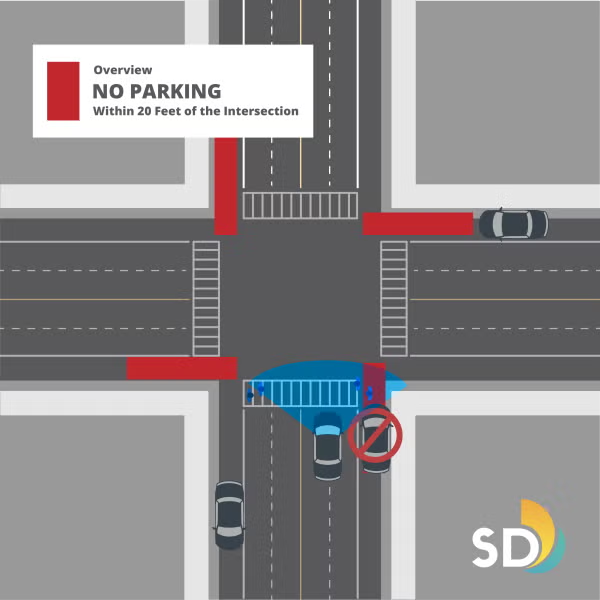California’s State Assembly Bill 413, a measure that prohibits cars from stopping, standing or parking within 20 feet of both red and unmarked intersections, went into effect Jan 1.
The Daylighting Parking Law’s goal is to give drivers and pedestrians more visibility around crosswalks.
Alex Irving, a second-year communications major, commutes to Marine Physical Training in Mission Bay twice a week. She experienced difficulty turning when cars were parked right along the intersection, blocking the view.
“There have been many times when I’ve had trouble taking a right turn because there’s a car in the way and it’s a tight road,” Irving said. “I see how the law was made to help pedestrians, and I think it will help prevent small accidents when turning in intersections.”
According to 2022 data from Sandag’s Traffic Safety Dashboard, 44% of San Diego’s collision-related injuries happened at intersections. Improper turns were a major culprit.
Sara DelGiudice, a fourth-year psychology major commuter, lives in the Point Loma area and found the law beneficial for navigating narrow roads in the neighborhood.
“In terms of safety, I think this law would allow drivers to feel less anxious about hitting someone from lack of visibility, which can likely reduce stress levels while driving,” DelGiudice said.
However, DelGiudice said she recognizes the possible consequences of limiting parking, especially in crowded areas like Ocean Beach and Downtown San Diego.
“Many people rely on street parking to go to stores or even to leave their car in front of their house,” she said. “By reducing the number of allotted spaces, citizens are left to search for even fewer open spots, and conflicts may arise because of it. Some people in San Diego get so aggressive over driving and parking.”
Vanessa Venegas, a second-year English education major, drives to Better Buzz, North Park and Sports Arena from PLNU’s main campus several times a week. She said that she thinks other drivers may not follow the law, not only because they might not know about it, but because not every curb is painted red.
“They should paint the sidewalk red so that people know they can’t park there,” Venegas said.
DelGiudice shared Venegas’ opinion that the city should prioritize marking these new off-limits parking spots.
“I also think it is unfair to uphold this law if there are no signs or indicators that you can not park in certain places by intersections. Many people probably won’t even have heard about this law and will receive a ticket for something that is not explicitly indicated on the street,” DelGiudice said.

The City of San Diego did not plan to invest the resources to paint every curb in all urban and suburban areas. However, efforts to paint curbs in busy and densely populated areas were made, according to the city’s daylighting webpage.
To help San Diegans with the transition, the city implemented a grace period from Jan. 1 to March 1, so people parking illegally will receive only warnings for the first 60 days of the year.
Once ticketing starts on March 1, tickets will match the current cost of parking at a red curb: $77.50.
